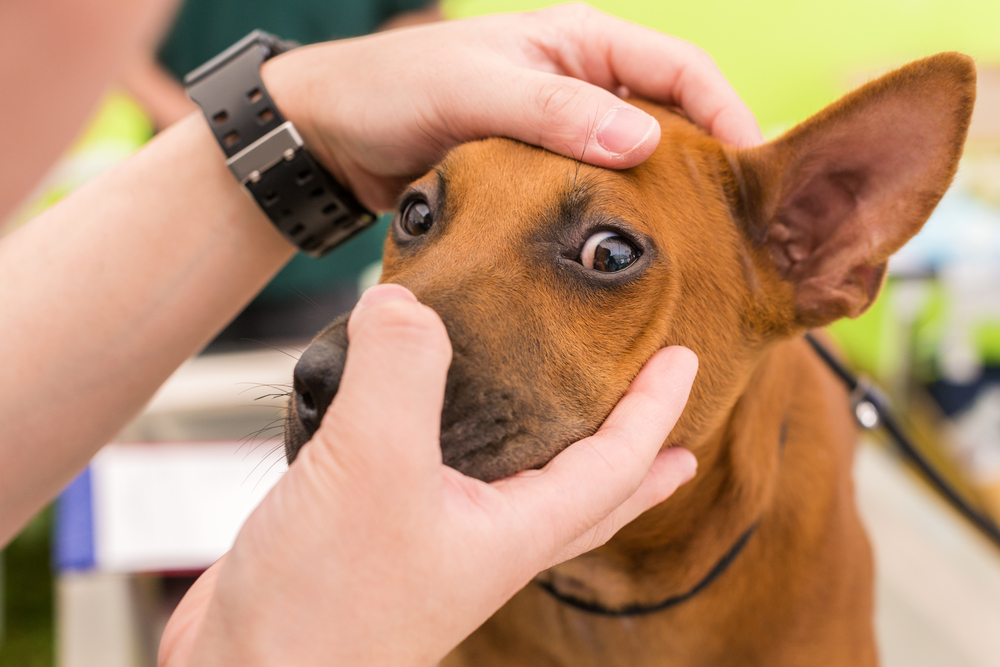Red Eyes, Squinting and Other Dog Eye Problems

Red eyes, excessive tearing, green or yellow discharge, squinting one or both eyes, and trouble seeing are dog eye problems that indicate you should have your pet’s eyes checked by a veterinarian.
What causes these eye problems in dogs? We’re here to answer these questions and emphasize the importance of vision health for your pets.
Red Eyes in Dogs
Red, bloodshot eyes in dogs or cats are not normal and should warrant a visit to your veterinarian. This is especially true if your pet is on steroid eye drops or if your pet has ongoing eye problems. The problem may be as simple as allergies or irritation from dust or pollen, but red eyes could be a sign of a more serious vision-threatening problem or disease such as:
- Foreign object
- Conjunctivitis
- Corneal ulcers
- Cataracts
- Glaucoma
- Injury such as blunt force trauma or a penetrating wound
- Uveitis, an inflammation of the inside of the eye
Some causes of a red eye are an immediate concern and need to be addressed quickly so that your pet has the best chance at maintaining vision and being comfortable. Your veterinarian can determine the source of the problem and how to solve it. Severe eye problems may need immediate surgery and require a referral to a veterinary eye care specialist.
Cherry Eye in Dogs
Cherry eye in dogs is a common disorder of the gland of the nictating membrane or third eyelid that sits in the inner corner of a dog’s eye. Cherry eye is more common in young dogs. A defect in the attachment of the tear gland can prolapse and protrude from behind the third eyelid and appear as a red, fleshy mass.
Cherry eye itself is not painful but exposure of this normally moist gland to the air can dry and irritate it. The most common treatment is surgery to restore it to its correct position. Untreated, cherry eye can lead to keratoconjunctivitis sicca (dry eye), conjunctivitis and corneal ulcers which can be chronic, cause pain and even lead to loss of the eye.
Squinting Too Much
If your pet is squinting, it may not seem like a big concern. You may think it is due to the sun or a bit of dust in the eye(s). If it continues, though, squinting can be an indicator of something more serious.
Squinting is commonly the result of a scratch to the cornea or a corneal ulcer. The cornea makes up the front of the eyeball. A corneal ulcer is an erosion of the outermost layer of the cornea, called the epithelium. If treated promptly, a corneal ulcer may heal within a few days.
If not treated properly, a corneal ulcer could become infected which would continue to erode the deeper layers of the cornea. If an ulcer gets deep enough, the eye can actually rupture. If this were to happen, the fluid and blood from inside the eye would leak out of the hole. This becomes a surgical emergency to place a graft on the eye to try and save it.
A corneal ulcer is hard to detect without special tests and equipment. It can be very painful and cause permanent vision loss and sometimes require surgical removal of the eye.
Dry or Watery Eyes in Dogs
Dry eye in dogs (keratoconjunctivitis sicca or KCS) results when there is a deficiency in the tear film. The loss of the water portion of the tear film will allow the cornea and conjunctiva to dry out, which then causes inflammation and irritation of those tissues. The most common cause of dry eye in dogs is immune-mediated. This is where the dog’s immune system actually destroys the tear glands.
Other causes can include certain systemic illnesses including diabetes, Cushing’s disease or hypothyroidism as well as some eye drops and systemic medications. If dry eye is not treated, it can lead to increased ocular discharge, corneal ulcers, and discomfort. Dry eye can be diagnosed by your veterinarian by performing a Schirmer Tear Test on your pet.
Watery eyes occur as a natural response to an irritant in the eye as a way to flush it out. Excessive tearing might be a result of ulcer, environmental allergens, a corneal ulcer, trauma to the eye, glaucoma, irritation from abnormal hairs around the eye, blockage of a tear duct and many other causes. No matter the cause, having a thorough eye examination is essential to diagnosis and treatment.
Your Solution for Dog Eye Problems
Other dog eye problems such as cataracts, glaucoma, lens luxation, and retinal detachment benefit from working with a knowledgeable veterinary eye care team. The OVRS eye care team is skilled in treating all types of eye diseases and conditions in dogs and cats. They have a wide array of diagnostic and therapeutic equipment. If you have any questions or concerns about your pet’s eyes, we are here to help. Please call us to schedule an appointment.


